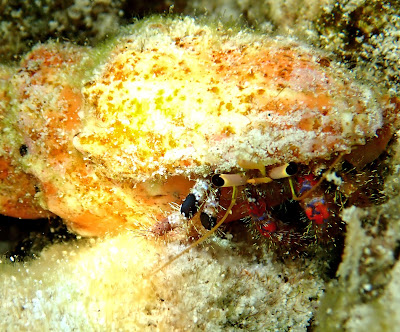 |
| Yellow Margin Moray eel Hunting at Kahalu'u June 2020 |
Over the weekend we were texting with Peter about meeting somewhere south on Monday. Considerations medical and meteorological mitigated in scrapping those plans. The rain stopped about 4 AM on Monday morning and by 8 I was Jonesing to go snorkeling. Opting for the easiest thing, schmoopie and I took the ten minute drive down the slopes of Hualalai to Kahalu'u.
 |
| Stout Moray Eel with Honey Cowry Behind |
moray who poked his nose querulously out the coral. Now some of you in the Peanut Gallery may shout out, "How do you know that isn't a whitemouth moray?" The answer is I don't know for sure. Our good friend and mentor, the Great Oz, himself, says that they frequently look similar, and in those instances, you won't know for sure until you see the inside of the mouth. So just say, "Aah."
In the same picture you will see a honey cowry sitting on the ledge behind the eel. This cowry is not rare, but unusual enough to make the list of significant sightings
Two quick eels had to be a harbinger of good things to come.
Still operating along the inner margin of the coral, about thirty yards off shore, I ran into a juvenile cleaner wrasse, the bright blue streak you have seen in recent blogs. Those tiny fish are irresistible, so I dove down to get a picture. He hid under the lip of a coral head, but while I was submerged, with
 |
| Gosline's Fang Blenny Kahalu'u June 2020 |
In this picture you can see the yellow dorsal line, which is frequently pictured in books, but rarely seen by me. Here is another instance where the camera is a big help.
Back around the corner, heading out to Surfer's rock, I spied a handsome punctured miter shell sitting on a coral ledge. Thinking that I would take a portrait of the shell, which boasted decorative hints of green algae, I placed it a bit closer to the surface. As I was getting ready to take the picture
 |
| Bloody Hermit, Dardanus sanguinocarpus, Kahalu'u June 2020 |
This is the largest hermit that I see in Hawaii. There are other large hermits in the critter book. While some occur at depth, several of them, also of the genus Dardanus, are reputed to occur in habitat like Kahalu'u and Kailua pier. Obviously, I need to keep examining shells.
At this time, with the tourists safely in their niches back in the lower 48 and in Japan, we are experiencing a rebirth at Kahalu'u. One finding is the resurgence of the coral, presumably in the absence of toxic sun screen. But another is the large number of shells we are seeing lying around. I never imagined that tourists were picking up the shells and removing them from the bay in large numbers. However, my experience in May and June can hardly be questioned: Tourists remove
 |
| The hermit crab pivoted this shell with relative ease. (See his tiny eyes?) |
When I think of this species, Dardanus sanguinocarpus, I picture it living in a triton shell. John Hoover shows two pictures of the bloody hermit crab in his book. In one, the crab inhabits a triton, In the other he is in a miter. As I looked through my pictures, I have to admit that I have found the bloody hermits as frequently in a miter shell as any other. In one instance, close by Kailua Pier, I found the bloody hermit in an enormous marlin spike auger. Its hard to imagine how strong this little crab has to be to manipulate that large, heavy shell. On this day, I watched while the hermit crab turned the miter shell around with relative ease.
 |
| Adult Sailfin tang showing off the extended fins Kahalu'u 2020 |
beauty, just crying out to have his picture taken. I hope you recall the baby sailfin we have been watching in Kawaihae harbor. Now you can compare him with this handsome adult. The fish swam around and around me. I'm choosing the picture for you that best displays his nominative sail fin. Isn't it lovely?
As I swam ashore, I was greeted by hula music. Sure enough, up in the shelter there was a group of ladies doing the hula, with Sandra watching. She reported that they are the Kona Wahines and meet for hula once a week. On that happy note, I'm going to dance off into the sunset. Aloha nui loa,
jeff

No comments:
Post a Comment